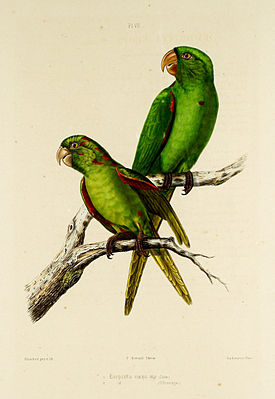Haiti Parakeet
| Haiti Parakeet | ||||||||||
|---|---|---|---|---|---|---|---|---|---|---|

Cuban Parakeet (front) and Haiti Parakeet (back) painted by Charles Émile Blanchard (1819–1900) |
||||||||||
| Systematics | ||||||||||
|
||||||||||
| Scientific name | ||||||||||
| Psittacara chloropterus | ||||||||||
| Souancé , 1856 |
The Haitian Parakeet ( Psittacara chloropterus ), sometimes also known as the Green-winged Parakeet , is a species of parrot in the genus Psittacara , which was separated from the Macaws ( Aratinga ) in 2013 . A distinction is made between two races: the nominate form Psittacara chloropterus chloropterus , which occurs on Hispaniola and the extinct Puerto Rican parakeet ( Psittacara chloropterus maugei ), which was native to the island of Mona and probably Puerto Rico .
features
The Haiti parakeet can reach a size of 32 cm and a weight of 150 grams. In the adult birds the wing bend, the wrist-root margin of the wings, the outermost middle wing-coverts and the outer under wing-coverts are red. The inner small under wing coverts are green. The undersides of the hand and arm wings are dull olive yellow. The beak is horn-colored. The protruding, featherless eye ring is creamy white. The iris is yellow. The legs are gray-brown. The wing length is 167 to 185 mm.
In juvenile birds there is no red color on the wing bend, on the carpal margin of the wings and on the outermost middle wing covers. The larger under wing coverts are less red. The base of the beak and the iris are gray.
The Puerto Rican parakeet was a bit smaller, its beak was darker, the red color under the hand covers lighter. The little hand covers were completely green with no reddish feathers.
Occurrence
The Haiti Parakeet occurs in the Massif de la Selle and Massif du Nord mountain ranges in Haiti and in the Sierra de Baoruco and Sierra de Neiba mountain ranges in the Dominican Republic . It was introduced in Puerto Rico, where the subspecies Aratinga chloroptera maugei occurred until the 1860s , and in Guadeloupe . In Florida , too , illegally introduced and released specimens were discovered in 1975, 1979 and 1992.
habitat
The Haiti parakeet inhabits different habitats from the lowlands to altitudes of up to 3000 m. These include dry lowland forests, the palm savannah, forest edges and moist highland forests, especially those that are dominated by conifers. Occasionally it can also be found on cultivated areas. It is often only found in undisturbed regions, especially in the middle altitudes.
Way of life
The Haiti Parakeet is a resident bird that can be seen in pairs, family groups, or small flocks of 8 to 10 individuals. In the past there were flocks of up to 100 birds. He is shy and alert, but not particularly careful when foraging. During his morning flights or in the seat control room , he is noisy and noticeable, with a high-pitched screeching to be heard. When eating the food in the foliage of the canopy, however, it is silent and remains well camouflaged due to its plumage. In the evening he goes to sleep. The pairs fly close together in a flock. The flight is nimble and straight with rapid wing beats.
literature
- Thomas Arndt : Lexicon of Parrots . 2001. Arndt-Verlag , Bretten.
- Joseph M. Forshaw : Parrots of the World: An Identification Guide . Princeton University Press, Princeton, New Jersey, and Woodstock, United Kingdom, 2006. ISBN 978-0-691-09251-5 , p. 105, plate 77
- Del Hoyo, J., Elliot, A. & Sargatal, J. (Editors) (1997). Handbook of the Birds of the World. Volume 4: Sandgrouse to Cuckoos . Lynx Edicions. ISBN 8487334229 , p. 431
Individual evidence
Web links
- Hispaniolan Parakeet - BirdLife Species Factsheet
- Lexicon of Parrots
- Psittacara chloropterus in the endangered Red List species the IUCN 2011. Posted by: BirdLife International, 2008. Accessed March 20, 2012th

